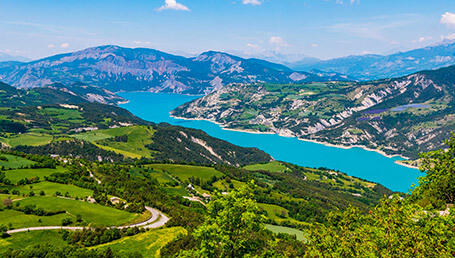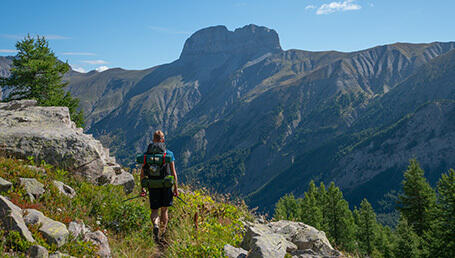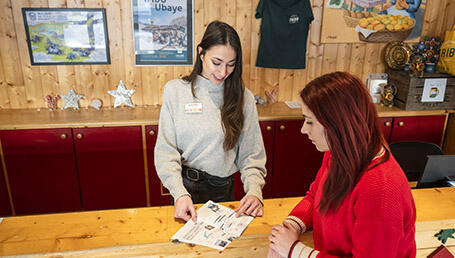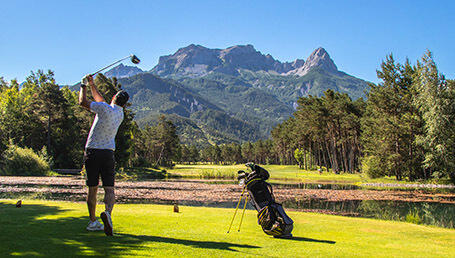

Ubaye Vallée de Barcelonnette
Welcome to paradise for lovers of the Great Outdoors
An area of natural surroundings with remarkable landscapes, the Ubaye Serre-Ponçon Valley is a truly unique place to escape to. The Mercantour National Park and the Natura 2000 areas – which are genuine biodiverse sanctuaries – share fundamental values with us of protecting nature and preserving the beauty of the mountains and the serenity of the surroundings.
From the Serre-Ponçon lake to the summits of the Haute-Ubaye, traversing steep gorges and forests of larch trees, the landscapes all complement each other while retaining their own different characteristics.
The 13 authentic villages of the Ubaye Serre-Ponçon Valley welcome you with open arms – whether you're looking to enjoy a lively town or the expanse of a secluded site, you're sure to be able to find a holiday that's perfect for you.



A mosaic landscape
The diversity of the Ubaye Serre-Ponçon Valley is reflected in the variety of its landscapes. Ranging between 800 and 3400 metres in altitude, they offer breathtaking panoramas of wild and preserved landscapes, both wide open and secretly tucked away.
Almost inaccessible, the peaks of the majestic massifs are visible in the background. There is a long list, but here are just a few of the most well-known and emblematic peaks: Brec du Chambeyron, Grand Bérard, Chapeau de Gendarme, Pain de Sucre, Grande Séolane, Tête de Louis XVI...
At the foot of these mountains flows the river that lends its name to our valley: the Ubaye. As the last naturally flowing river in the Alps, it is internationally renowned among fans of white water sports. The river Ubaye rises at the Col du Longet and stretches for 80 km before flowing into the Serre-Ponçon lake, (the largest artificial water reservoir in France). The turquoise waters of the lake form an oasis of relaxation for lovers of water sports, swimming and those who simply enjoy kicking back and relaxing.
The Ubaye Serre-Ponçon Valley can also be discovered from the air. Its exceptional upper air conditions have turned it into a Mecca for gliding and paragliding, and a location that is renowned throughout Europe.
From the air, the hundred or so high lakes, mountain peaks and larch forests create a breathtaking mosaic of landscapes.
The land forms a route through the heart of the Southern Alps, with the Ubaye Serre-Ponçon Valley sharing its borders with Italy, the Hautes-Alpes, the Alpes Maritimes and Provence. It is also surrounded by 7 legendary passes, including the famous Col de la Bonette, which at 2802 metres, is the highest tarmac road in France.
Its enhanced site means it an essential stopover on such legendary routes as the Grande Traversée des Alpes or the Route des Grandes Alpes.
The charm of the roads of the Ubaye Serre-Ponçon Valley are evident at every turn, offering a genuine invitation to travel and marvel at the surroundings, providing incomparable driving pleasure as you move through landscapes, each one more incredible than the last.
There are so many exceptional locations providing unique experiences!
A territory rich in history
Marvel at the unique historical and architectural heritage of the Ubaye Serre-Ponçon Valley. The numerous cultural sites and remains that are scattered throughout the area bear witness to the richness of our history and the region's history.
The "Mexican" villas of Barcelonnette and Jausiers add a curiously exceptional aspect to these towns. Built between 1880 and 1930, these beautiful bourgeois houses narrate the story of the thousands of Ubayans who left for America in the 19th century intent on developing their expertise and skills, particularly in the textile industry. Some returned to the country, having made their fortunes, and constructed these sumptuous villas as a testimony to their success. Even today, there are still deep links between the Ubaye Valley and Mexico.
The exceptional geographical features of the Ubaye Serre-Ponçon Valley mean it is a veritable crossroads between Piedmont, Savoy and Provence, and therefore of major strategic military interest between the 19th and 20th centuries. Some of the Ubayan mountains have been transformed into real fortresses, a number of which have now been opened as museums. The most impressive and perhaps emblematic of these constructions remains the Fort of Tournoux. Nicknamed the ‘Military Versailles', it is made up of several batteries distributed over more than 700 metres of uneven ground.










